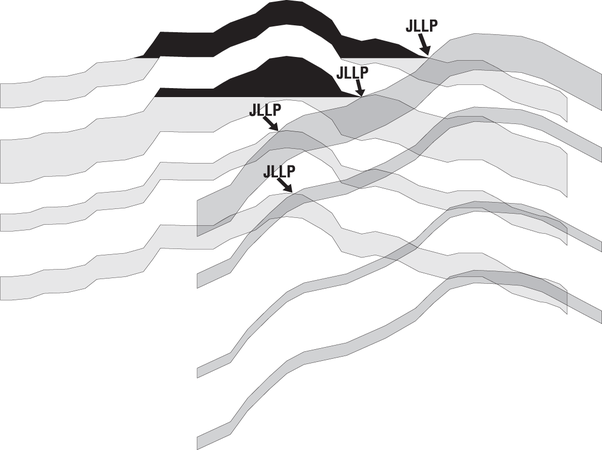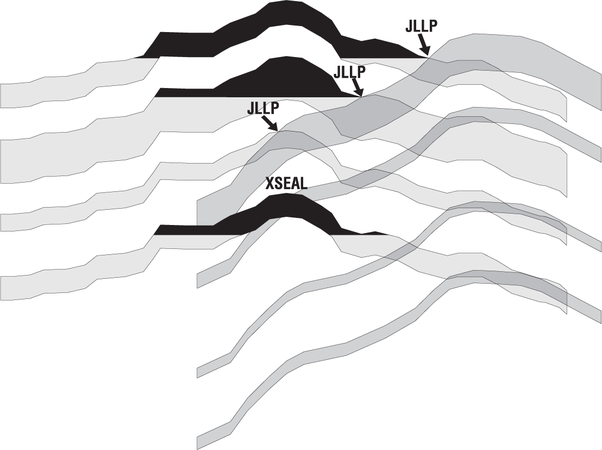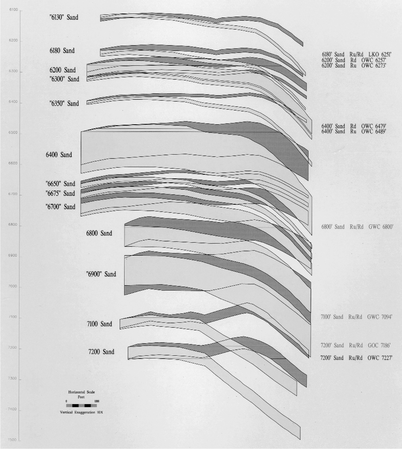Difference between revisions of "Fault plane profile construction"
Cwhitehurst (talk | contribs) |
Cwhitehurst (talk | contribs) m (added Category:Treatise Handbook 3 using HotCat) |
||
| (19 intermediate revisions by 2 users not shown) | |||
| Line 6: | Line 6: | ||
| part = Predicting the occurrence of oil and gas traps | | part = Predicting the occurrence of oil and gas traps | ||
| chapter = Evaluating top and fault seal | | chapter = Evaluating top and fault seal | ||
| − | | frompg = 10- | + | | frompg = 10-18 |
| − | | topg = 10- | + | | topg = 10-19 |
| author = Grant M. Skerlec | | author = Grant M. Skerlec | ||
| link = http://archives.datapages.com/data/specpubs/beaumont/ch10/ch10.htm | | link = http://archives.datapages.com/data/specpubs/beaumont/ch10/ch10.htm | ||
| Line 14: | Line 14: | ||
| isbn = 0-89181-602-X | | isbn = 0-89181-602-X | ||
}} | }} | ||
| − | + | A [[fault plane profile]] (FPP) is a [[cross section]] in the plane of the [[fault]] that shows both the [[hanging wall]] and [[footwall]] cutoffs.<ref name=ch10r86>Van Wijhe, D. H., M. Lutz, and J. P. H. Kaasschieter, 1980, The Rotliegend in the Netherlands and its gas accumulations: Geologie en Minjbouw, vol. 59, no. 1, p. 3–24.</ref><ref name=ch10r2>Allan, U. S., 1989, [http://archives.datapages.com/data/bulletns/1988-89/data/pg/0073/0007/0800/0803.htm Model for hydrocarbon migration and entrapment within faulted structures]: AAPG Bulletin, vol. 72, no. 7, p. 803–811.</ref><ref name=ch10r35>Hardman, R. F. P., and J. E. Booth, 1989, [http://archives.datapages.com/data/bulletns/1988-89/data/pg/0073/0007/0800/0812.htm Structural interpretation of hydrocarbon traps sealed by [[basement]] normal fault block faults at stable flank of foredeep basins and at rift basins]: AAPG Bulletin, vol. 72, no. 7, p. 813–840.</ref>Fault plane profiles are a fundamental tool for prospect assessment as well as a first step in understanding [[seal]] behavior in existing fields. Fault plane profiles are important because they show what is being juxtaposed across the fault. By doing so, they show areas of sand/sand and sand/shale juxtaposition, establish seal relationships, define potential fault-dependent [[Trap leakage|leak points]], and help assess [[hydrocarbon volume]]s. | |
An FPP is distinctive in two ways: | An FPP is distinctive in two ways: | ||
| Line 22: | Line 22: | ||
==Procedure== | ==Procedure== | ||
| − | We construct an FPP as we do any geologic cross section. Using structure-depth maps, we project the top of each mapped stratigraphic unit at its intersections with the fault plane to its correct depth on the fault plane profile.<ref name=ch10r2>Allan, U. | + | We construct an FPP as we do any geologic [[cross section]]. Using [[Subsurface_maps#Structure|structure-depth maps]], we project the top of each mapped stratigraphic unit at its intersections with the fault plane to its correct depth on the fault plane profile.<ref name=ch10r2>Allan, U. S., 1989, [http://archives.datapages.com/data/bulletns/1988-89/data/pg/0073/0007/0800/0803.htm Model for hydrocarbon migration and entrapment within faulted structures]: AAPG Bulletin, vol. 72, no. 7, p. 803–811.</ref> |
Because only a fraction of the stratigraphy is mapped routinely, well logs are used to project the remainder of the detailed stratigraphy onto the FPP. | Because only a fraction of the stratigraphy is mapped routinely, well logs are used to project the remainder of the detailed stratigraphy onto the FPP. | ||
| Line 28: | Line 28: | ||
==Example: FPP of cross-leaking fault== | ==Example: FPP of cross-leaking fault== | ||
| − | [[file:evaluating-top-and-fault-seal_fig10-15.png| | + | [[:file:evaluating-top-and-fault-seal_fig10-15.png|Figure 1]] is a simple example of a fault plane profile. The sand reservoirs in the hanging wall (dark gray) and footwall (light gray) are shown on the same cross section drawn in the plane of the fault. In this example, all hydrocarbon [[accumulation]]s (black) are limited by [[Cross-leaking_faults#Juxtaposed_lithology_leak_points|JLLPs (juxtaposed lithology leak points)]]. Hydrocarbons cross-leak from the footwall sands into the hanging wall sands. |
| − | + | The fault cross-leaks along its entire surface at sand/sand juxtapositions. At each sand/sand juxtaposition, a JLLP spills the hydrocarbons across the fault. There is sufficient [[Calculating charge volume|charge]] to fill all closures to a fault-dependent leak point. Potential reservoirs with JLLPs at the crest are [[dry]]. The percent fill for other sands is constrained by the JLLPs.<ref name=ch10r2 /> If bed dips in the hanging wall allow entrapment against the fault, hydrocarbons could be trapped in both the hanging wall and footwall reservoirs. With sufficient charge, common hydrocarbon contacts could exist. | |
| − | |||
| − | The fault cross-leaks along its entire surface at sand/sand juxtapositions. At each sand/sand juxtaposition, a JLLP spills the hydrocarbons across the fault. There is sufficient charge to fill all closures to a fault-dependent leak point. Potential reservoirs with JLLPs at the crest are dry. The percent fill for other sands is constrained by the JLLPs.<ref name=ch10r2 /> If bed dips in the hanging wall allow entrapment against the fault, hydrocarbons could be trapped in both the hanging wall and footwall reservoirs. With sufficient charge, common hydrocarbon contacts could exist. | ||
==Example: FFP that cross seals, cross leaks== | ==Example: FFP that cross seals, cross leaks== | ||
| + | <gallery mode=packed widths=300px heights=300px> | ||
| + | file:evaluating-top-and-fault-seal_fig10-15.png|{{figure number|1}}Example of a fault plane profile. | ||
| + | file:evaluating-top-and-fault-seal_fig10-16.png|{{figure number|2}}The fault plane profile with cross sealing at the fault/reservoir intersection in the lowest foot-wall sand. | ||
| + | file:evaluating-top-and-fault-seal_fig10-26.png|{{figure number|3}}Fault plane profile of a fault in a Gulf Coast field. | ||
| + | </gallery> | ||
| − | + | The fault plane profile in [[:file:evaluating-top-and-fault-seal_fig10-16.png|Figure 2]] is similar to the profile in [[:file:evaluating-top-and-fault-seal_fig10-15.png|Figure 1]] except that the fault is cross sealing at the fault/reservoir intersection in the lowest foot-wall sand. Despite a sand/sand juxtaposition at the crest of this reservoir, the fault traps hydrocarbons at a cross sealing segment. Higher sands continue to cross-leak. The percent fill of the lowest sand is limited by either the [[displacement pressure]] (P<sub>d</sub>) of the fault zone, the [[Calculating charge volume|charge volume]], or the top seal—not a JLLP. | |
| − | |||
| − | |||
| − | |||
| − | The fault plane profile in [[:file:evaluating-top-and-fault-seal_fig10-16.png|Figure 2]] is similar to the profile in [[:file:evaluating-top-and-fault-seal_fig10-15.png|Figure 1]] except that the fault is cross sealing at the fault/reservoir intersection in the lowest foot-wall sand. Despite a sand/sand juxtaposition at the crest of this reservoir, the fault traps hydrocarbons at a cross sealing segment. Higher sands continue to cross-leak. The percent fill of the lowest sand is limited by either the P<sub>d</sub> of the fault zone, the charge volume, or the top seal—not a JLLP. | ||
[[:file:evaluating-top-and-fault-seal_fig10-26.png|Figure 3]] is an example of a fault plane profile of a fault in a Gulf Coast field. | [[:file:evaluating-top-and-fault-seal_fig10-26.png|Figure 3]] is an example of a fault plane profile of a fault in a Gulf Coast field. | ||
==See also== | ==See also== | ||
| − | + | ||
* [[Fault plane profile analysis pitfalls]] | * [[Fault plane profile analysis pitfalls]] | ||
| Line 58: | Line 57: | ||
[[Category:Predicting the occurrence of oil and gas traps]] | [[Category:Predicting the occurrence of oil and gas traps]] | ||
[[Category:Evaluating top and fault seal]] | [[Category:Evaluating top and fault seal]] | ||
| + | [[Category:Treatise Handbook 3]] | ||
Latest revision as of 14:51, 29 March 2022
| Exploring for Oil and Gas Traps | |

| |
| Series | Treatise in Petroleum Geology |
|---|---|
| Part | Predicting the occurrence of oil and gas traps |
| Chapter | Evaluating top and fault seal |
| Author | Grant M. Skerlec |
| Link | Web page |
| Store | AAPG Store |
A fault plane profile (FPP) is a cross section in the plane of the fault that shows both the hanging wall and footwall cutoffs.[1][2][3]Fault plane profiles are a fundamental tool for prospect assessment as well as a first step in understanding seal behavior in existing fields. Fault plane profiles are important because they show what is being juxtaposed across the fault. By doing so, they show areas of sand/sand and sand/shale juxtaposition, establish seal relationships, define potential fault-dependent leak points, and help assess hydrocarbon volumes.
An FPP is distinctive in two ways:
- It is a cross section in the plane of the fault rather than normal to the fault.
- Both the hanging wall and footwall stratigraphic cutoffs are shown on the same cross section.
Procedure[edit]
We construct an FPP as we do any geologic cross section. Using structure-depth maps, we project the top of each mapped stratigraphic unit at its intersections with the fault plane to its correct depth on the fault plane profile.[2]
Because only a fraction of the stratigraphy is mapped routinely, well logs are used to project the remainder of the detailed stratigraphy onto the FPP.
Example: FPP of cross-leaking fault[edit]
Figure 1 is a simple example of a fault plane profile. The sand reservoirs in the hanging wall (dark gray) and footwall (light gray) are shown on the same cross section drawn in the plane of the fault. In this example, all hydrocarbon accumulations (black) are limited by JLLPs (juxtaposed lithology leak points). Hydrocarbons cross-leak from the footwall sands into the hanging wall sands.
The fault cross-leaks along its entire surface at sand/sand juxtapositions. At each sand/sand juxtaposition, a JLLP spills the hydrocarbons across the fault. There is sufficient charge to fill all closures to a fault-dependent leak point. Potential reservoirs with JLLPs at the crest are dry. The percent fill for other sands is constrained by the JLLPs.[2] If bed dips in the hanging wall allow entrapment against the fault, hydrocarbons could be trapped in both the hanging wall and footwall reservoirs. With sufficient charge, common hydrocarbon contacts could exist.
Example: FFP that cross seals, cross leaks[edit]
The fault plane profile in Figure 2 is similar to the profile in Figure 1 except that the fault is cross sealing at the fault/reservoir intersection in the lowest foot-wall sand. Despite a sand/sand juxtaposition at the crest of this reservoir, the fault traps hydrocarbons at a cross sealing segment. Higher sands continue to cross-leak. The percent fill of the lowest sand is limited by either the displacement pressure (Pd) of the fault zone, the charge volume, or the top seal—not a JLLP.
Figure 3 is an example of a fault plane profile of a fault in a Gulf Coast field.
See also[edit]
References[edit]
- ↑ Van Wijhe, D. H., M. Lutz, and J. P. H. Kaasschieter, 1980, The Rotliegend in the Netherlands and its gas accumulations: Geologie en Minjbouw, vol. 59, no. 1, p. 3–24.
- ↑ 2.0 2.1 2.2 Allan, U. S., 1989, Model for hydrocarbon migration and entrapment within faulted structures: AAPG Bulletin, vol. 72, no. 7, p. 803–811.
- ↑ Hardman, R. F. P., and J. E. Booth, 1989, Structural interpretation of hydrocarbon traps sealed by basement normal fault block faults at stable flank of foredeep basins and at rift basins: AAPG Bulletin, vol. 72, no. 7, p. 813–840.


